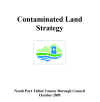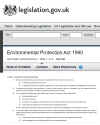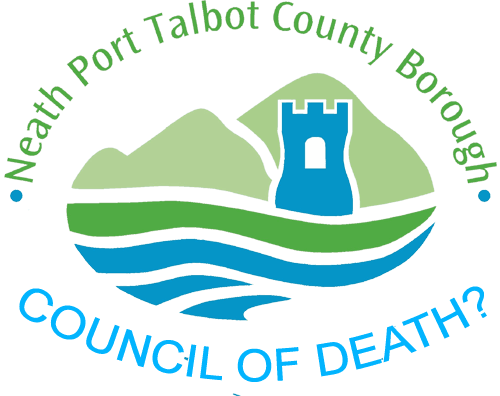|
Glynneath residents. Are the Neath-Port Talbot Council Planning your Death? |
INTRO - BACKGROUND INFO
| me arriving in front of the board and looking up | ||
| view of the site and Enzo info board in the distance - cars passing | To the local council this land known is known as "the land south of Heol y Glyn in Glynneath" To local residents it is known as the 'ash tip' or just the 'tip'. | |
| view of the site from the board | The reason for this is because for the majority of the last 80 years the land has been both domestic and industrial landfill, a council tip from around 1940 to 1970 and industrial landfill since then. It was once owned by the asbestos removal experts, the Cuddy Group who at one time were the 12th largest demolition contractor in the world, a lot of their waste has been tipped here. | |
| cut to the board and
enzo intro in front of sign |
The Neath-Port Talbot Council first gave planning permission for a housing development at the site in 1989. |
|
| Returning home and the action of visiting the NPTC planning website | In 2005 planning permission was granted again to the Cuddy Group and the NPTC placed a list conditions on this permission which the developer had to meet in order for them to complete the development.. | |
| condition 17 image | 
|
One of these conditions was that a "Geotechnical Survey" of the ground be submitted . |
| front cover | 
|
As part of this condition, a Geo-technical and Geo-environmental report was submitted on the 26 November 2008. |
Was Contaminated Land Identified ?
Was Contaminated Land Identified ?
YES
What should have happened then?
| CLS 2005 | 
|
The Neath-Port Talbot Council regulations for contaminated land in 2008 were contained in the 2005 NPTC Contaminated Land Strategy. This document states |
| fading in to 82 | "Part IIA of the Environment Protection Act 1990, was introduced in Wales on July 1st 2001, until this time there had been no strategic approach to the identification of contaminated land. Land contamination had always been addressed during redevelopment or when the risk has manifested itself. Since 2001, all local authorities have a duty to inspect their areas, locate and ensure the remediation of all statutory designated contaminated land. One of the key objectives of the council's strategy (Key Objective 4:) is to ensure that during the redevelopment of new sites, land contamination issues are dealt with effectively and at an early stage of the planning process." | |
| EPA | 
|
The document says that the contamination should have been dealt in the early stages of the planning process and if we refer to the.................. Environmental Protection Act 1990 - Part IIA ........Identification of contaminated land. The opening points of which
are................ |
| EPA image tick and cross | 
|
(a) of identifying contaminated land; and This video will show that the Neath-Port Talbot Council identified contaminated land but rather than deciding whether the land was required to be designated as a special site, instead they worked together with the Cuddy Group to hide the contamination. Thereby placing the residents of Glynneath at risk from cancer causing chemicals. |
Evidence of contamination
What did happen?
 |
The application containing the Geo-Technical survey with the contamination information was withdrawn on 2/4/2009. No reason was given for its withdrawal and the Geo-technical and Geo-environmental report or contamination within it were never referred to again in the planning process until we discovered it in the planning department archives in March 2020.
|
|
 |
On the 23 April 2010 the Neath Port Talbot Council planning department approved a new set of plans for the development. The conditions did not mention contamination, chemical testing or any remediation of the site. | |
 |
If we refer again to the Contaminated Land Strategy we will see
that the planning department have neglected their
responsibilities, the strategy states that:
"When considering an application, where contaminated land is involved the planning authority will identify specific measures to be undertaken prior to redevelopment, these requirements will be imposed by a set of conditions attached to the planning permission." |
|
 |
The conditions also allowed the Cuddy Group to submit a new Geotechnical Survey without chemical testing which they did in 2016 through a different company. | |

|
Based upon the available evidence:
That contamination was identified. Contamination has been hidden in the planning archives for the last 10 years Plans were re-submitted and approved without the mention of chemical testing or of any conditions imposed relating to the contamination. There is no evidence of remediation. A new Geotechnical Survey without chemical testing was allowed The Neath-Port Talbot Council have breached the 1990 Environmental Protection Act. |
|

|
They were provided evidence that the land was contaminated and
they have failed to identify whether or not the land should be
designated as a special site according to the 1990 Environmental
Protection Act.
(b) of enabling the authority to decide whether any such land is land which is required to be designated as a special site Which brings us to the our original question. Based upon the facts presented I have asked myself the questions: Are the Neath-Port Talbot Council planning the death of Glynneath residents? you decide?
|
|
 |
The majority of this video contains screenshots and images. I guarantee that every piece of information that I provide in this video has come from legitimate government sources and has not been tampered with in anyway. The opinions contained in this video are the personal opinions of myself, David Richards.I stand accountable for my opinions and I will fight to my very last breath to protect my family from council negligence and corruption. Supporting evidence to this video including the text and images can be found by following the links on.................
|
|
